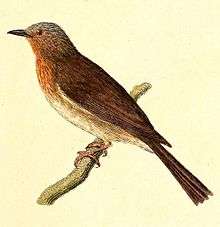Philippine bulbul
| Philippine bulbul | |
|---|---|
 | |
| Scientific classification | |
| Kingdom: | Animalia |
| Phylum: | Chordata |
| Class: | Aves |
| Order: | Passeriformes |
| Family: | Pycnonotidae |
| Genus: | Hypsipetes |
| Species: | H. philippinus |
| Binomial name | |
| Hypsipetes philippinus (Forster, 1795) | |
 | |
| Synonyms | |
|
Ixos philippinus (Forster, 1795) | |
The Philippine bulbul (Hypsipetes philippinus) is a songbird species in the bulbul family (Pycnonotidae). It is often placed in the genus Ixos, but is better retained in Hypsipetes as long as this is not entirely merged into Ixos, as it is quite closely related to the type species of Hypsipetes, the black bulbul (H. leucocephalus).[2]
It is endemic to the Philippines. Its natural habitats are subtropical or tropical moist lowland forests and subtropical or tropical moist montane forests; on Mount Kitanglad on Mindanao for example it is abundant in any kind of primary forest at least between 500 and 2,250 m ASL.[3] Both the Mindoro bulbul and the Visayan bulbul were formerly considered subspecies.
Fledglings of the Philippine bulbul were recorded on Mindanao in late April, but the breeding season seems to be prolonged as females with ripe ovarian follicles were still found in April and May. Territorial songs are heard at lower altitudes as late as May, while further upslope the birds are silent at that time of year and presumably engaged in breeding activity. The besra (Accipiter virgatus) has been recorded as a predator of young Philippine bulbuls, and this or other goshawks might also catch adult birds.[4]
A common and adaptable bird as long as sufficient forest remains, it is not considered a threatened species by the IUCN.[5]
Footnotes
- ↑ BirdLife International (2012). "Ixos philippinus". IUCN Red List of Threatened Species. Version 2013.2. International Union for Conservation of Nature. Retrieved 26 November 2013.
- ↑ Gregory (2000), Pasquet et al. (2001), Moyle & Marks (2006), BLI (2008)
- ↑ BLI (2008), Peterson et al. (2008)
- ↑ Peterson et al. (2008)
- ↑ BLI (2008)
References
- Gregory, Steven M. (2000): Nomenclature of the Hypsipetes Bulbuls (Pycnonotidae). Forktail 16: 164-166. PDF fulltext
- Moyle, Robert G. & Marks, Ben D. (2006): Phylogenetic relationships of the bulbuls (Aves: Pycnonotidae) based on mitochondrial and nuclear DNA sequence data. Mol. Phylogenet. Evol. 40(3): 687-695. doi:10.1016/j.ympev.2006.04.015 (HTML abstract)
- Pasquet, Éric; Han, Lian-Xian; Khobkhet, Obhas & Cibois, Alice (2001): Towards a molecular systematics of the genus Criniger, and a preliminary phylogeny of the bulbuls (Aves, Passeriformes, Pycnonotidae). Zoosystema 23(4): 857-863. PDF fulltext
- Peterson, A. Townsend; Brooks, Thomas; Gamauf, Anita; Gonzalez, Juan Carlos T.; Mallari, Neil Aldrin D.; Dutson, Guy; Bush, Sarah E. & Fernandez, Renato (2008): The Avifauna of Mt. Kitanglad, Bukidnon Province, Mindanao, Philippines. Fieldiana Zool. New Series 114: 1-43. DOI:10.3158/0015-0754(2008)114[1:TAOMKB]2.0.CO;2 PDF fulltext
